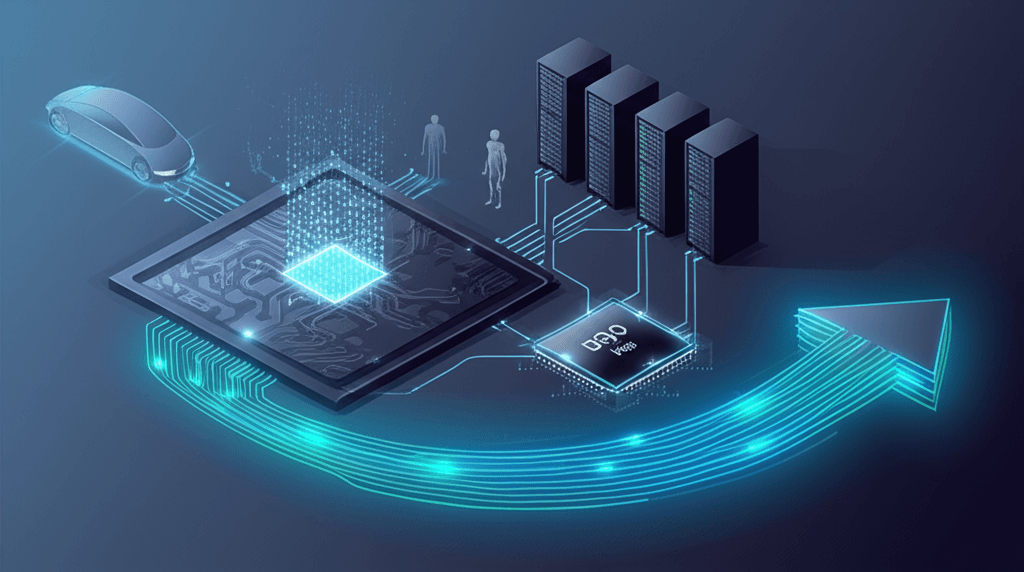Tesla Scraps Ambitious Dojo Supercomputer, Pivots AI Hardware Strategy
Tesla abandons its ambitious Dojo supercomputer, opting for external AI power and a unified internal chip strategy.
August 8, 2025

Tesla has reportedly shut down its ambitious in-house supercomputer project, known as Dojo, and reassigned the team working on it.[1][2][3] The move represents a significant strategic pivot for the electric vehicle manufacturer, ending a years-long effort to build bespoke AI training hardware from the ground up and signaling a greater reliance on external technology partners for its formidable computing needs. The decision, reportedly ordered by CEO Elon Musk, marks a departure from a vision that once positioned Dojo as a critical component for advancing the company's goals in autonomous driving and robotics.[1][3] The project, centered around a custom D1 chip, was designed to process the immense volumes of video data collected from Tesla's global fleet of vehicles, a dataset considered essential for training its Full Self-Driving (FSD) software.[4][5]
The winding down of the Dojo project is accompanied by significant personnel changes.[6] Peter Bannon, the executive who was leading the initiative, is reportedly leaving the company.[1][2][6] This follows a trend of key talent departing the Dojo team, with approximately 20 employees recently leaving to form a new AI startup called DensityAI.[1][2][7] This new venture, founded by former Dojo head Ganesh Venkataramanan, aims to develop chips and software for AI data centers, robotics, and automotive applications, mirroring the original ambitions of Tesla's project.[2][8] The remaining members of the Dojo team are being reassigned to other data center and computing projects within Tesla.[1][6] This strategic shift comes despite previous optimistic projections from Musk, who as recently as a late July earnings call, suggested a new version of Dojo would be operating at scale in the coming year.[1]
The reasons behind this abrupt change in strategy appear to be multifaceted, stemming from a combination of talent attrition, persistent project delays, and a pragmatic re-evaluation of its AI hardware strategy.[1][4] In a post on X, Elon Musk explained the decision by stating, “It doesn’t make sense for Tesla to divide its resources and scale two quite different AI chip designs.”[2][6][9] This points to a consolidation of efforts around its other in-house chip designs, specifically the upcoming AI5 and AI6 processors, which are intended for "inference" tasks inside its vehicles and robots rather than the large-scale "training" that Dojo was built for.[6][9] The company has reportedly signed a substantial $16.5 billion deal with Samsung to produce these next-generation chips.[2][4] By ceasing development on the specialized Dojo architecture, Tesla can focus its resources on a single, more versatile chip lineage.[6][10] Furthermore, the company is expected to deepen its reliance on established industry leaders like Nvidia and AMD for the massive computing power required for training its AI models, a move that leverages proven technology and may accelerate development timelines.[11][3][12]
This pivot carries significant implications for Tesla's core projects, most notably its Full Self-Driving (FSD) and Optimus humanoid robot programs.[13] Both initiatives are heavily dependent on massive-scale AI model training. While Tesla already operates a large supercomputing cluster powered by thousands of Nvidia GPUs, Dojo was intended to provide a custom, hyper-efficient solution specifically for its video-centric workloads.[5][14] The shutdown means Tesla will now lean more heavily on external suppliers like Nvidia, on whose hardware it already planned to spend between $3 billion and $4 billion in the current year.[15][16] While this approach leverages the mature and powerful ecosystem provided by market leaders, it relinquishes the potential long-term competitive advantage and cost savings that a successful, vertically integrated custom hardware solution like Dojo could have offered.[8][17] The focus now shifts to the AI5 and AI6 chips, which Musk claims will be "excellent for inference and at least pretty good for training."[6] He has even suggested that a future cluster of these chips could be considered "Dojo 3," indicating a path forward that still involves custom silicon but in a different form.[6]
The decision to shutter Dojo reverberates throughout the broader AI industry, offering a high-profile case study in the "build versus buy" dilemma for specialized AI hardware.[18][19] While tech giants like Google, Amazon, and Meta have also invested in creating their own custom AI chips to optimize performance and reduce costs, the journey is fraught with challenges, including immense development costs, long timelines, and the risk of the hardware becoming obsolete as AI models rapidly evolve.[19][20][21] Tesla's move to abandon its bespoke training supercomputer in favor of hardware from established players like Nvidia could be interpreted as a pragmatic acknowledgment of these difficulties.[22][23] It underscores the immense challenge and risk associated with developing vertically integrated hardware solutions from scratch, even for a company with Tesla's resources and engineering talent. The exodus of talent to a new startup also highlights the fierce competition for specialized AI expertise, a factor that can significantly impact the viability of such ambitious internal projects.[23][8]
In conclusion, Tesla's termination of the Dojo supercomputer project is a decisive strategic shift, moving away from a high-risk, high-reward plan for bespoke training hardware.[1] The company is now consolidating its focus on its next-generation inference chips and deepening its partnerships with established technology providers like Nvidia and Samsung to meet its immense AI training demands.[2][11][12] This recalibration, driven by project delays, talent departures, and a desire to unify its chip design efforts, effectively ends one of Tesla's most ambitious technical endeavors.[1][4] While the move may accelerate near-term progress by leveraging proven technologies, it also signals a retreat from a path of full vertical integration that once promised to give Tesla a unique and powerful advantage in the race to develop fully autonomous systems and general-purpose robots. The future of Tesla's AI ambitions will now be more closely tied to the capabilities of its external partners and its own forthcoming AI5 and AI6 chips.[6]
Sources
[1]
[4]
[7]
[9]
[10]
[11]
[12]
[13]
[14]
[15]
[16]
[17]
[18]
[19]
[20]
[22]
[23]